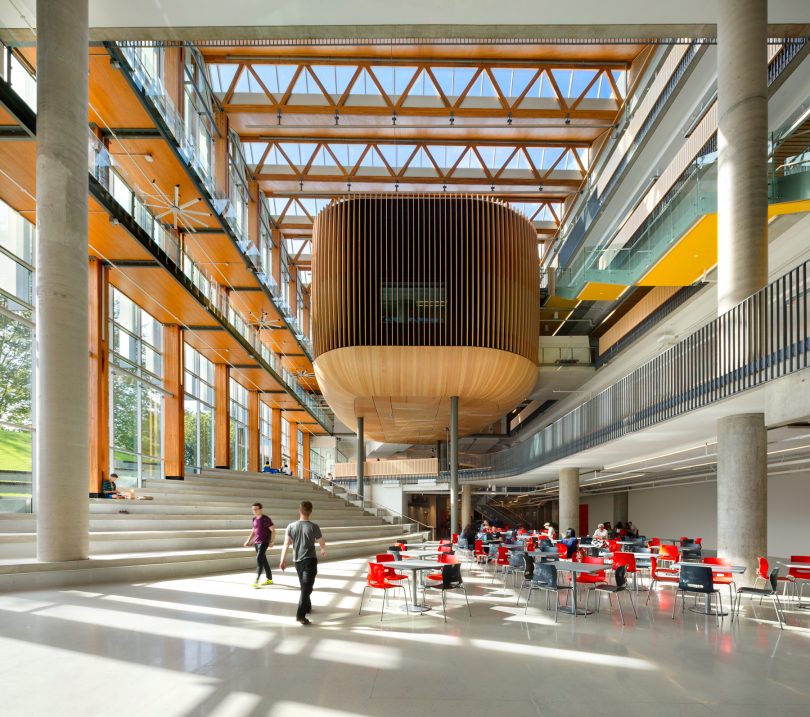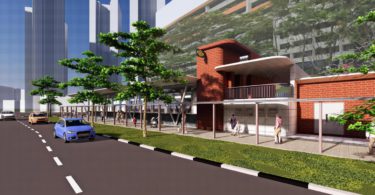By Matthias A. Olt
Technology, awareness and understanding of timber as a construction material continue to advance and we are seeing possibilities open up. Amidst the increasing popularity of prefabricated concrete and other advanced technologies, timber is still adopted as a material of choice for many different building types at varying scales as it offers competitive advantages like no other. Below are some benefits of mass timber buildings.
IMPROVING OCCUPANT’S WELLNESS
It has been proven that wood and other natural materials can reduce stress, promote a sense of calm and well-being, as well as improve productivity and focus. Scientific research has shown the positive benefits of fresh air, acoustics and daylight on learning, and recent evidence suggests that materiality of a space impacts health, well-being and personal performance similarly.
Spaces graced by natural materials such as wood evoke a sense of connection with living things. Environments that feature wood bring nature indoors and trigger positive psychological and physiological responses. Spending time in rooms constructed with a moderate balance of wooden surfaces reduces cortisol levels. People respond more positively to spaces where wood is present, perceiving wood interiors as warm, inviting and relaxing.
Being in contact with wood also reduces the stress hormone oxyhaemoglobin. A Japanese study measured oxyhaemoglobin concentrations and found that oxyhaemoglobin levels were about 50 per cent lower after touching wood for 90 seconds, compared to touching marble, tile or metal.
SOCIO-ENVIRONMENTAL VALUES AND BRAND POSITIONING
The younger generation today has grown up with the realities of climate change, waste, pollution, resource depletion and population growth. They are paying attention and becoming more discerning. They make decisions about where to study, work and live based on the socio-environmental values of companies and organisations. They prioritise those that make a positive impact on the environment, as well as protect health and well-being.
Sustainable wood production sequesters carbon over the lifetime of the building, estimated to last over 100 years. Meanwhile, producing one tonne of concrete emits nearly one tonne of carbon dioxide into the atmosphere.
In terms of user and tenant expectations, mass timber not only delivers health and wellness benefits but also amenability to exploration and organic structures. This can also prove to be a powerful factor in talent attraction and retention by making visible an organisation’s identity and core values. Many companies and institutions are recognising such appeal of mass timber as an essential component of their brand positioning.
STRUCTURAL RESILIENCE AND FLEXIBILITY
Mass timber enables a variety of composite applications with other materials. Unlike reinforced concrete, exposed mass timber components can be easily monitored and replaced over time. In contrast with concrete and steel, structural assemblies made of engineered wood can be easily modified to accommodate changing requirements over time.
Ancient wooden temples in Japan and timber structures in Europe are testaments to the periodic component replacement and the adaptability of wooden structures over centuries. In addition, structures made with mass timber components meet stringent seismic and fire design requirements.
The lightweight nature of mass timber compared to steel or concrete offers additional benefits. It reduces the building cost due to lighter substructure and foundations. It also offers an attractive solution for adaptive reuse, where pre-existing foundations can be used for lightweight additions in mass timber.
About the author:

Matthias A. Olt is a design director for architecture at B+H, a sustainable design expert, as well as a keynote speaker and author with 26 years of professional expertise. He is a registered architect with an undergraduate degree in material science who led the design of several tall, high-profile mixed-use, commercial and residential buildings of up to 275 metres. Matthias is an expert in mass timber design and the recipient of the Seattle AIA Honor Award for an innovative mass timber high-rise building. He has built a competitive, sustainable design practice for a large, global architecture firm by spearheading firm-wide sustainable design strategic plan: internal programmes, marketing, tool development and staff design training.











